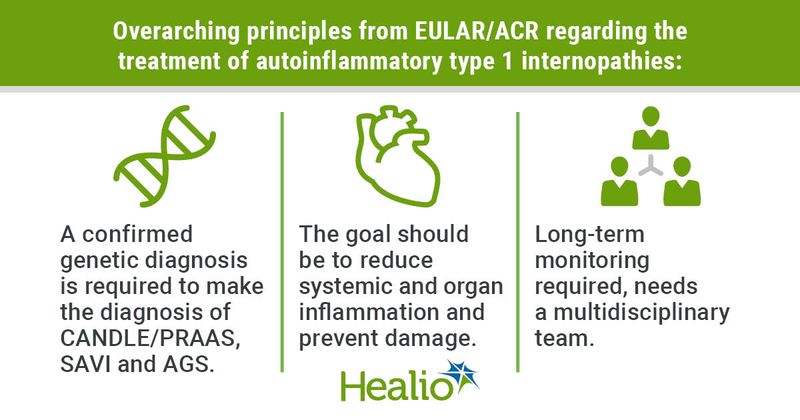EULAR/ACR: Complex immunodysregulatory diseases require multidisciplinary approach
The diagnosis, treatment, and long-term monitoring of patients with autoinflammatory type 1 interferonopathies require a multidisciplinary approach, according to joint guidelines released by EULAR and the American College of Rheumatology.
The new points to consider, published in the Annals of the Rheumatic Diseases, cover the diagnosis and management of patients with chronic atypical neutrophilic dermatosis with lipodystrophy and elevated temperature/proteasome-associated autoinflammatory syndrome (CANDLE/PRAAS), stimulator of interferon genes-associated vasculopathy with onset in infancy (SAVI), and Aicardi-Goutières Syndrome (AGS) — all rare and clinically complex immunodysregulatory diseases.

“Despite CANDLE/PRAAS, SAVI and AGS having distinct clinical phenotypes of varying disease severity, the individual clinical manifestations of these diseases can overlap, and all are associated with high morbidity and mortality if untreated,” Kader Cetin Gedik, MD, of the NIH, and co-authors wrote. “The objective of this project was to develop points to consider for the diagnosis, treatment and long-term monitoring of patients with CANDLE/PRAAS, SAVI and AGS.”
To develop the points to consider, Gedik and colleagues formed a task force including experts from North America, South America, Europe and Australia. Members met during a face-to-face meeting in August 2019 to define their goals and target populations, then outlined the relevant research questions for a literature review of data published before September 2020.
The members used the literature review and two Delphi-technique surveys to develop draft statements that were sent to the entire voting committee prior to the consensus meetings. For each disease, the voting panel consisted of 19 experts, one allied health professional and one patient representative. Statements that received more than 80% consensus were accepted. Any items with less than 80% approval were discussed before a secondary vote.
The new points to consider range in scope from evaluation to treatment, to comorbidities, to vaccines. For diagnostic evaluation, considerations include:
Patients presenting with unexplained systemic inflammation — including elevations of CRP, ESR and/or an IFN signature — and clinical features such as rashes, lipodystrophy, musculoskeletal, neurologic, pulmonary and metabolic findings should receive a “prompt diagnostic workup” for CANDLE/PRAAS, SAVI and AGS, including genetic evaluation, clinical evaluation and screening for comorbidities.
Patients with CANDLE/PRAAS, SAVI or AGS clinical symptoms who do not carry any disease-causing mutations should be referred to specialty/research centers that can guide additional workup and treatment.
For genetic evaluation, considerations include:
Mutations in disease-causing genes should be included in the genetic analyses.
Genetic mimics of CANDLE/PRAAS, SAVI and AGS are recognized and should also be included in the diagnostic workup.
For clinical evaluation, considerations include:
For patients with suspected CANDLE/PRAAS, SAVI or AGS, assessment for disease and treatment related comorbidities should include screening for dermatologic, ophthalmic, cardiologic and other symptoms.
Providers should perform neuroimaging in patients with suspected neurologic symptoms.
For those with presumed CANDLE/PRAAS, SAVI or AGS, tissue sampling may support the diagnosis as appropriate.
All patients should undergo a basic immunodeficiency workup, including a history of infections, lymphocyte subsets and immunoglobulin levels, as a minimum.
For treatment, considerations include:
Treatment of CANDLE/PRAAS, SAVI and AGS should be aimed at achieving disease control or low disease activity to prevent progression of organ damage. For patients with SAVI and CANDLE/PRAAS, disease control should be maintained with the lowest possible dose of glucocorticoid.
Janus kinase (JAK) inhibitors can improve symptoms in CANDLE/PRAAS, SAVI and AGS.
Screening for treatment-related comorbidities is important for patients with CANDLE/PRAAS, SAVI or AGS on JAK inhibitors. The task force recommends monitoring for BK viral loads in urine and blood to prevent viral organ injury.
Glucocorticoids can improve symptoms in CANDLE/PRAAS or SAVI. However, chronic glucocorticoids do not improve neurological features of AGS. Still, acute courses of glucocorticoids may be useful for treating non-CNS inflammatory conditions.
For long-term monitoring and management, considerations include:
A multidisciplinary management team is required for optimal care of patients with CANDLE/PRAAS, SAVI and AGS. Care must be customized based on patient’s disease manifestations.
Disease activity and burden should be regularly monitored depending on severity.
Growth and development should be monitored in children at each visit.
There is currently no evidence to suggest that the risk for COVID-19 among patients with CANDLE/PRAAS, SAVI or AGS is any different from healthy comparators. Treatment for interferonopathy should therefore continue unless a specific contraindication to ongoing therapy arises.
For CANDLE/PRAAS and SAVI, all routine vaccines — live and killed — are generally indicated when not receiving immunosuppressive treatments or glucocorticoids, although this should be considered on a case-by-case basis.
“These points to consider address the multiple challenges of managing patients with these ultrarare diseases, by providing guidance on improving clinical recognition, support for decision-making on genetic testing as well as treatment and long-term management,” Gedik and colleagues wrote.
